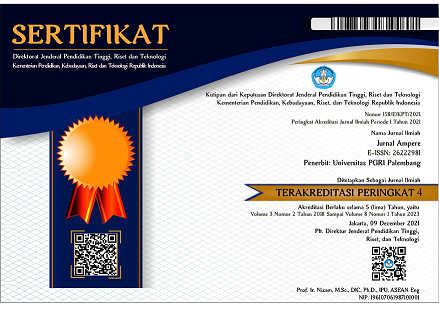PERANCANGAN SISTEM ANTRIAN PENDAFTARAN MAHASISWA BERBASIS KOMPUTER
DOI:
https://doi.org/10.31851/ampere.v4i2.3451Keywords:
queue, enrollment, counter, microcontroller ATMega16, loudspeakerAbstract
Almost in every private university, the enrollment of the prospective students is conducted every month, thus in some periods, there will be some overlapping with the enrollment for the current students. To overcome the extensive queue, especially at the university that has thousands of students, an automatically programmed and reliable queue system is needed. The queue system can substitute the designated person who distributes the ticket number and call the order. The hardware consists of computer, keypad, ATMega16 microcontroller, RS-232 communication, and USB to serial converter. Input from the keypad is processed by the computer using Borland Delphi. Computer is connected with the microcontroller and the other hardware. The queue system will visualize the queue number and the directed counter number in the LCD monitor and play the recorded sound file through the loudspeaker. The test result from this queue system has successfully generated an information about the queue number and directed counter number in the monitor and loudspeaker, and also control the overwhelmed queue to be more organized.
Â
Abstrak  Hampir di setiap perguruan tinggi swasta, pendaftaran calon mahasiswa baru dilakukan setiap bulan, sehingga pada masa tertentu akan terjadi pelayanan mahasiswa lama yang bersamaan dengan calon mahasiswa baru. Untuk mengatasi kepadatan antrian yang panjang pada perguruan tinggi yang jumlah mahasiswanya ribuan, dibutuhkan sistem antrian yang handal dan terprogram secara otomatis. Sistem antrian yang dirancang dapat menggantikan petugas khusus untuk memberikan nomor antrian dan memanggil nomor antrian. Perangkat keras yang digunakan terdiri dari komputer, beberapa tombol tekan, mikrokontroler ATMega16, komunikasi RS- 232, dan konverter USB to serial. Masukan yang berasal dari tombol tekan diolah oleh komputer menggunakan program Borland Delphi. Komputer dihubungkan dengan mikrokontroler dan perangkat keras lainnya. Sistem antrian akan menghasilkan tampilan informasi nomor antrian dan nomor loket pada monitor LCD dan mengaktifkan file rekaman suara sebagai pemberitahuan melalui loudspeaker. Hasil pengujian sistem antrian telah berhasil memberikan informasi nomor antrian dan loket yang sesuai pada layar monitor maupun loudspeaker, serta telah berhasil mengatasi kepadatan antrian menjadi lebih teratur.
Kata Kunci: antrian, pendaftaran, loket, mikrokontroler ATMega16, loudspeaker
References
Andrianto, Heri. 2015. Pemrograman Mikrokontroler AVR ATMEGA16 Menggunakan Bahasa C (Codevision AVR). Bandung: Penerbit Informatika.
ATMEGA16 Datasheet. (http://www.alldata sheet.com, diakses 20 April 2019).
Sumardi. 2013. Mikrokontroller, Belajar AVR Mulai dari Nol. Yogyakarta: Graha Ilmu.
Stallings, William. 2016. Computer Oganization and Architecture, 10th edition. New Jersey: Pearson Education.
MAX232 Datasheet. (http://www.alldata sheet.com, diakses 20 April 2019).
Barrow, John. Miller, Linda. Malan, Katherine. 2001. Introducing Delphi Programming, 4th edition. Georgia: Oxford University Press.
Downloads
Published
How to Cite
Issue
Section
License

Jurnal Ampere is licensed under a Creative Commons Attribution-ShareAlike 4.0 International License.
Authors who publish with this journal agree to the following terms:
- Authors retain copyright and grant the journal right of first publication with the work simultaneously licensed under a Creative Commons Attribution License that allows others to share the work with an acknowledgement of the work's authorship and initial publication in this journal.
- Authors are able to enter into separate, additional contractual arrangements for the non-exclusive distribution of the journal's published version of the work (e.g., post it to an institutional repository or publish it in a book), with an acknowledgement of its initial publication in this journal.
- Authors are permitted and encouraged to post their work online (e.g., in institutional repositories or on their website) prior to and during the submission process, as it can lead to productive exchanges, as well as earlier and greater citation of published work.






